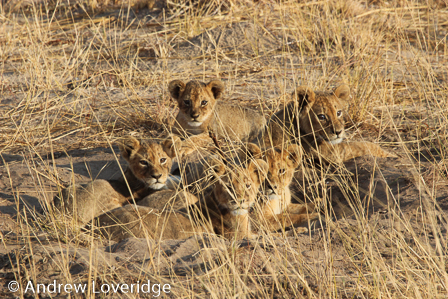Research
Lions and The Trans-Kalahari Predator Programme
History and Milestones
Cecil the Lion & WildCRU’s Cecil Summit
Area of Operation
Lion Ecology
Monitoring Populations
Transboundary and Landscape Conservation
Human-Lion Coexistence
Research Methods
The Team
Sponsors & How to Support Us
References
African lion populations have suffered an estimated 75% range reduction in the last 100 years. Continent wide, there may be as few as 20,000 lions left in the wild with many isolated populations recently disappearing or facing imminent extinction, for which habitat loss and human-wildlife conflict have been identified as primary drivers. The Trans-Kalahari Predator Programme is one of WildCRU’s largest projects, focused on the predators of southern Africa and their conservation and interactions with people. It was initiated in 1999 with the Hwange Lion Research Project in Zimbabwe and was extended into neighbouring Botswana in 2013 to form the Trans-Kalahari Predator Programme. The programme encompasses ecological research with a focus on African lions (and increasingly other predators), ecologically sustainable transboundary land use management in the Kavango-Zambezi Transfrontier Conservation Area and the promotion of coexistence of humans and predators to simultaneously improve human livelihoods and safeguard globally threatened lion populations.
2nd April, 2018 – Dr Andrew Loveridge speaks to Liz Hoath of CBC ‘The Current’ about Cecil, lion conservation, and human wildlife coexistence.
The African lion as an important umbrella species
Due to its vital role within an ecosystem, its unique biology and its combination of ecological needs, the African lion represents an important umbrella species for African landscapes. The apex predator roams home ranges of up to 2,000 km² and is essential for ecosystem function and health by controlling herbivore population sizes. Long-distance dispersal movements of mostly young males ensure genetic exchange between different lion populations, and dispersal distances of several hundred kilometres have been recorded. Due to their large area requirements many other smaller ranging species subsequently benefit indirectly from conservation efforts focused on the protection of African lion habitat, an effect which ecologists describe as holding an “umbrella” over additional species. In the face of a rapidly growing human population in Africa and the associated need for land and resources, there is limited time to prioritize effective conservation efforts that satisfy the needs of both humans and wildlife. Therefore, the umbrella species concept is a useful tool to manage landscape scale conservation and enable comprehensive habitat protection benefitting ecosystems as a whole.










